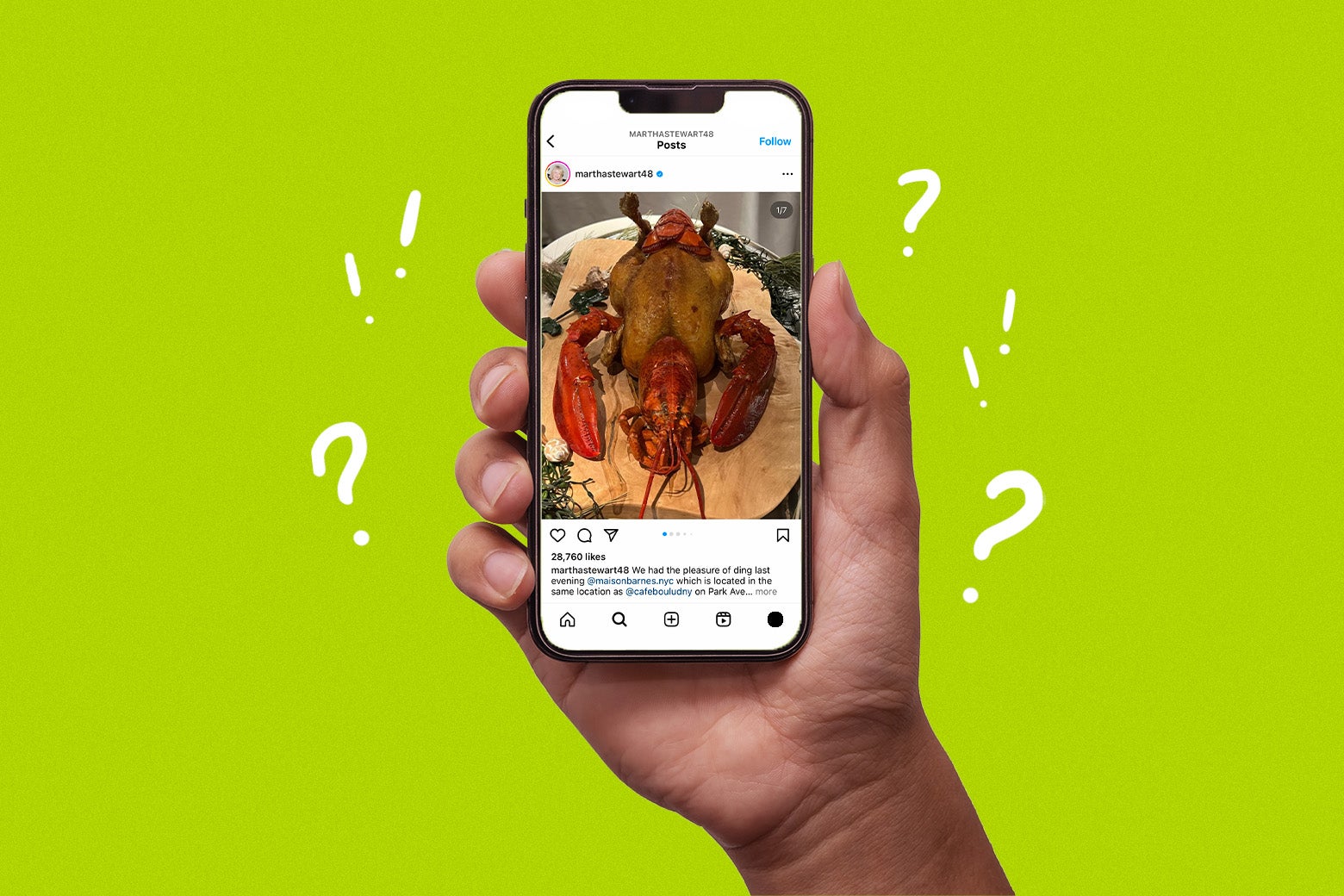Martha Stewart has always maintained an eclectic Instagram presence. Perhaps you remember the lacy, soft-focus thirst traps, or the poolside vamping, or her solid fundamentals at the Topgolf driving range. The legendary media tycoon is now 82 years old, and remains steadfast in her determination to share the good life with us unwashed masses. Even though she’s always surprising online, one post that hit Stewart’s social feeds this week caught me off guard. She shared a slideshow with classically dubious composition and lighting, showing off the dishes she ordered from Maison Barnes, a newly opened quadruple-dollar-sign French brasserie on the Upper East Side. Amid the liver pate and citrus-scented mixed greens was what appeared to be a lobster that had been stuffed—Frankenstein-style—into a roast chicken. I could try to explain further, but really, this leviathan needs to be seen to be believed.
Lord have mercy. What is going on here? Is it Mastering the Art of French Cooking according to David Lynch? Was it harvested from the eighth dimension? Is it going to attach to my head and suck my brains out? Are these what the unseen aliens in 3 Body Problem look like? Beyond the provocative intention of the plating—just look at that poor lobster’s exoskeleton mounted around the chicken, like it’s undergone a satanic rite—I find myself baffled by the concept behind the flavor profile. Breast meat and lobster is simply not a combination you’re going to find on many menus in America. I had plenty of questions, and thankfully Romain Paumier, executive chef of Maison Barnes and its sister restaurant Café Boulud, patiently answered some of them.
“This dish is a classic, but it’s usually made with crayfish,” said Paumier, who, it should be said, is well-reviewed and most certainly knows what he’s talking about. “It was created in the 19th century, and it has disappeared with modern cuisine. This is my attempt to bring back those ideas, and also to make it into a bit of a show.”
On the Maison Barnes menu, the dish is called Poularde Homardine, which literally translates to “lobster chicken.” The restaurant serves it table side, usually for two to three people, and it goes for $250, according to the menu. Contrary to what you might assume from the plating, the recipe does not call for a chef to roast a whole lobster inside a poultry carcass. Yes, Paumier does use every part of the crustacean in the preparation of the dish, but the crimson-scalded chunks surrounding the chicken are mostly there for decoration. In fact, the only piece of the lobster that is cooked with the bird is its head, which is flambéed with cognac and is removed from the chicken while it’s carved. The method gives the poultry a sweet infusion of lobster flavor, accentuated even further when the head’s juices are squeezed into a sauce made from a base of lobster bisque, chicken jus, and crème fraîche—which truly is about as French as it gets.
As for the lobster tail? Well, that’s just poached in aromatics, glazed with butter, and served alongside the chicken. Simple as that. When you drill down to its nuts and bolts, the physical act of eating the Poularde Homardine is far less baroque and perverted than it looks. It just makes a hell of a first impression.
After all, Stewart offered a rave review of the dish on her Instagram, and Paumier is of course correct when he asserts that French culinary aesthetes have been combining briny shellfish with the mild richness of oven-baked chicken for centuries. (Here is a New York Times recipe, for Poulet aux écrevisses, or “chicken with crayfish or shrimp,” published in 1982. Alain Ducasse, one of the foremost French chefs on the planet, included a similar recipe in his own cookbook.) Paumier himself refers to the dish as France’s very own take on surf and turf—the much more American idea of serving a butter-bathed lobster tail with a bone-in ribeye. He also was not surprised at all—and, in fact, was encouraged—by the people who filled Stewart’s Instagram comments with cries of shock and horror. (The top one reads, “Girl, respectfully what the fuck.”)
“Some people are going to be amazed, and some people are going to be shocked. They’re going to say, ‘Why are you combining the chicken with the lobster?’ That’s what I expected, especially from American people, because this is not their culture,” said Paumier. “It’s what we want. Food is an art. If you do something that is ordinary, people are going to forget about it.”
Maison Barnes just celebrated its grand opening on March 11, so the Poularde Homardine is early in its experimental period. I myself have yet to try the dish, because I am rarely in a position to drop a couple hundred dollars for dinner and drinks. But Stewart and Paumier have piqued my interest, and I hope to make my trip uptown soon. Savoring an inconceivable blend of flavors presented, table side, looking straight out of Area 51? It’s a good thing.
